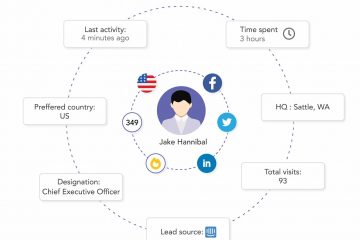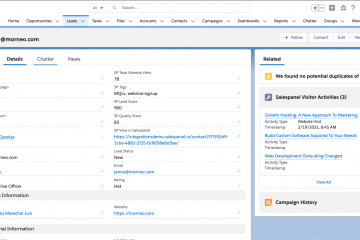Demand Generation vs Lead Generation
“Demand generation” and “lead generation” are two terms that any digital marketer will be familiar with and know. Some people believe that the two are basically the same thing, with demand generation being a fancier way to say lead generation. There are genuine differences between these two concepts. So, let’s look at the difference between demand generation and lead generation.
What is Lead Generation?
Lead generation involves encouraging people who are interested in your products and services to go through with a sign up or provide you their contact information. Lead generation involves creating a content and marketing landscape that captures information about a prospect through things such as lead forms, gated content, and sign-up sheets.
An example of lead generation is to create gated content on a website to get people to provide their information. You might create a white paper or ebook to add value to the customer and encourage them to make the purchase.
Offering someone something of value gives them an incentive to provide you with something of value in return: their contact information. Run ads to increase awareness of the gated content and bring in more prospects.
What is Demand Generation?
Demand generation, as the name implies, is the process of building awareness for products and services. Demand generation combines several marketing approaches to target potential customers at every point of the purchasing journey. Marketing establishes a key relationship with these potential customers and makes them desire the thing a company has to offer them.
People often mistake demand generation with inbound marketing. There are similarities between the two; they both involve creating valuable content that is genuinely informative and giving it out to potential customers. With that said, demand generation includes much more than just inbound marketing. If anything, inbound marketing is only one aspect of a larger demand generation strategy.
Key Differences Between Lead Generation and Demand Generation
Demand generation and lead generation are different in that demand generation creates awareness and brings people directly to your company/business, and lead generation is primarily used to turn those interested people into “leads.” The goal of lead generation is to push people forward through the purchasing journey. In a way, demand generation leads to lead generation.
It is important to have a look at the different content used by each method to understand their differences better. Demand generation is powered by free content that can include articles and blog posts. Lead generation, by comparison, uses “gated content” that people can’t access without giving something in return, such as their email address.
Lead generation allows marketing teams to continue to advance the relationship with prospects and push them to purchase your products and services. There’s no need to choose between them as both of them can be used together for an effective marketing strategy.
Be sure to take into account the intent and purpose of any content that you create. Do you want to build more awareness, or do you want to use the content to generate leads? If you were to publish an ebook to build awareness, then it would be demand generation. As a result, you should allow people to instantly gain access to the ebook without having to fill anything in and provide their contact information.
Having complete free access to the content means it’s easier and more convenient for people to share that content with people they know. However, if you want to use the ebook to find leads and encourage them along the buying process, then it is considered lead generation. The ebook should be put behind a “gate,” where people have to fill out a form to obtain it. As you can see, the two systems work together, so it’s practically impossible to only use one without the other one.
Lead Generation Ideas
Here are some ideas for lead generation to get you started:
Write an eBook
An eBook makes for a great lead magnet for any website. The eBook you create could cover a broad topic for your industry. That way, you can promote it all across your website because it is relevant to so many things.
Create Content Upgrades
Content upgrades are another form of lead magnet used to encourage people to enter their contact information. Compared to the more general eBook, a content upgrade is often more specific and related to individual blog posts. Content Upgrade gives your reader a bonus content that is directly related to your blog post. For example, if a customer is reading a blog post about lead scoring, they are more likely to download a lead scoring ebook.
Host a Webinar
Invite other industry experts to participate in a webinar. Webinars are an excellent way to obtain contact information from the audience. All you have to do is have them sign up to participate and watch the webinar. There’s plenty of software out there – such as Demio and WebinarJam – that can help to set up and run a webinar.
Demand Generation Ideas
Here are some demand generation ideas to get you started:
Create SEO-Focused Content
Every marketer knows that content is king. One way to generate leads is by creating content related to what the audience is searching for. Check out Google searches related to your industry and consult an SEO expert to get started.
Create Guest Posts
Creating a guest post is when you write a blog post that someone else in the industry will publish for you. Creating guest content for other people is a great way not only to reach your own audience but be seen by another audience that you wouldn’t usually have access to.
Create Industry Expert Roundups
Not sure what to do a blog post on? Try an industry expert roundup. These roundups are posts containing quotes from experts in the industry related to topics the audience will like. Roundups are easy to share and quickly make the rounds across social media. Contributors to the post are also likely to share the post themselves to reach their audience.
Closing Thoughts
There are some key differences between lead generation and demand generation. Rather than pick one or the other, try to understand that they perfectly complement each other. Why settle for one when you can – and should – have both?
Sell more, understand your customers’ journey for free!
Sales and Marketing teams spend millions of dollars to bring visitors to your website. But do you track your customer’s journey? Do you know who buys and why?
Around 8% of your website traffic will sign up on your lead forms. What happens to the other 92% of your traffic? Can you identify your visiting accounts? Can you engage and retarget your qualified visitors even if they are not identified?



